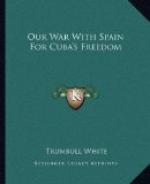It was not long before the enemy gave way and ran down the steep hill and up another hill to the blockhouse, with the evident intent of making a final stand there.
Colonel Wood was at the front directing the movement and it was here that Major Brodie was shot. Colonel Wood and Lieutenant Colonel Roosevelt both led the troops in pursuit of the fleeing Spaniards and a hail of bullets was poured into the blockhouse. By the time the American advance got within 600 yards of the blockhouse the Spaniards abandoned it and scattered among the brush up another hill in the direction of Santiago, and the battle was at an end.
During all this time just as hot a fire had been progressing at General Young’s station. The battle began in much the same manner as the other one, and when the machine guns opened fire the Spaniards sent volleys at the gunners from the brush on the opposite hillside. Two troops of cavalry charged up the hill and other troops sent a storm of bullets at every point from which the Spanish shots came. The enemy was gradually forced back, though firing all the time until they, as well as those confronting the Rough Riders, ran for the blockhouse only to be dislodged by Colonel Wood’s men.
General Young stated afterwards that the battle was one of the sharpest he had ever experienced. It was only the quick and constant fire of the troopers, whether they could see the enemy or not, that caused the Spaniards to retreat so soon. General Young spoke in the highest terms of the conduct of the men in his command, and both Colonel Wood and Lieutenant Colonel Roosevelt were extremely gratified with the work done by the Rough Riders on the first occasion of their being under fire.
When it became evident that the Spaniards were giving up the fight, searching parties went through the thicket and tall grass, picking up the dead and wounded. The latter were carried to a field hospital half a mile to the rear and all possible attention was given them, while preparation was made to remove them to Juragua.
Army in A baptism of fire.
After a period of comparative idleness the campaign was opened in earnest Friday, July 1, when General Shafter’s army began an attack at dawn upon the Spanish fortifications. Shatter had come from Cuero to El Caney with his army, making headquarters at Siboney. From these points the Spanish troops under General Linares had retreated a short distance and taken San Juan hill, from which they had accurate range of the American batteries. Shafter’s forces were without sufficient guns, while the Spaniards had more and of a heavier caliber than was anticipated.




